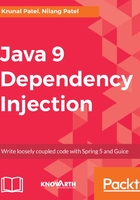
上QQ阅读APP看书,第一时间看更新
Implementing DIP through IoC
DIP suggests that high-level modules should not depend on low-level modules. Both should depend on abstraction. IoC provides a way to achieve the abstraction between high-level and low-level modules.
Let's see how we can apply DIP through IoC on our Balance Sheet example. The fundamental design problem is that high-level modules (balance sheet) tightly depend on low-level (fetch and export data) modules.
Our goal is to break this dependency. To achieve this, IoC suggests inverting the control. In IoC, inverting the control can be achieved in the following ways:
- Inverting the interface: Make sure the high-level module defines the interface, and low-level modules follow it
- Inverting object creation: Change the creation of dependency from your main modules to some other program or framework
- Inverting flow: Change the flow of application